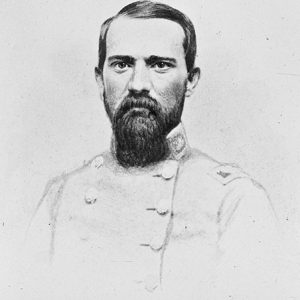calsfoundation@cals.org
Second Arkansas Infantry Battalion (CS)
The Second Arkansas Infantry Battalion was a Confederate unit that served in the Eastern Theater during the American Civil War. It was one of only three Arkansas units to serve in Virginia, along with the First and Third Arkansas Infantry regiments. Decimated during the Seven Days Battles, it saw its survivors discharged or transferred into the Third Arkansas Infantry.
In September 1861, three independent companies organized at Hot Springs (Garland County), Pine Bluff (Jefferson County), and El Dorado (Union County). On the recommendation of recruiting officers for the First Arkansas Infantry, they journeyed to Virginia to join that regiment. When the three companies arrived, the First Arkansas had the required ten companies. On October 29, 1861, the three new companies were enrolled as the Second Arkansas Infantry Battalion and attached to the First Arkansas Infantry. Major William N. Bronaugh, a former professor at St. Johns’ College in Little Rock (Pulaski County), was appointed as commander. The companies were commanded by Captains Joseph Gregory, Henry H. Beavers, and John R. Lacey.
The battalion was reassigned to the brigade of Brigadier General Samuel French and spent the last of 1861 and into early 1862 on picket duty along the Potomac River in the Aquia District of Virginia. When the Union army under General George McClellan began its advance up the Yorktown Peninsula toward Richmond in late spring, the Second Arkansas Battalion traveled south and was included in forces for defense of the capital city. By June, it was transferred to Brigadier General Dorsey Pender’s Brigade consisting of the Sixteenth, Twenty-second, and Thirty-eighth North Carolina Infantry regiments, and the Twenty-second Virginia Battalion, all assigned to Major General Ambrose P. Hill’s “Light” Division.
During the Peninsula Campaign, or the Seven Days Battles, the Second Arkansas Battalion would receive its baptism by fire in the clash along Beaver Dam Creek near Mechanicsville, Virginia, on June 26, 1862. The Federals held an extremely strong position behind a swamp and associated beaver dam. The Confederates were forced to cross open ground in their attempt to drive the enemy away. The Second Arkansas Battalion, as part of the first wave, made the charge in the face of heavy artillery and rifle fire. Unable to drive the enemy from their strong positions, the Confederate advance ground to a halt, experiencing heavy casualties.
The Second Arkansas Battalion started the battle with approximately 208 men. Toward the end of the fight in front of the enemy works, Major Bronaugh, mortally wounded, had only twelve men still with him, as well as their flag. At morning roll call the next day, forty-two men were present for duty. General Pender mentioned the “loss on Thursday of a most competent and gallant officer, Maj. W. N. Bronaugh, of the Second Arkansas Battalion. With his death ceased the battalion as far as was concerned its usefulness on the field.” The Richmond Times Dispatch carried a lengthy story detailing the gallant conduct of the Second Arkansas Battalion on June 28, 1862, two days after the battle along Beaver Dam Creek: “The Arkansas battalion lost more men in proportion to its numbers than that of any other of the command. They went into the fight like men, and discharged their duty bravely.”
As best as can be determined, the Second Arkansas Battalion lost twenty-seven killed and more than 100 wounded on June 26, 1862. With all the battalion officers and non-commissioned officers dead or wounded, no after-action report was written, and no official casualty list created. In July, 139 survivors of the battalion were transferred into companies F and I of the Third Arkansas Infantry. Most were soon discharged due to previous wounds or sickness and returned to Arkansas, where many eventually returned to duty. Those who were missing were noted as having “no further record” on their military records. These were presumably the men who died along Beaver Dam Creek. Many of those who joined the ranks of the Third Arkansas became casualties at Gettysburg, Chickamauga, the Wilderness, and Spotsylvania. At the surrender of General Robert E. Lee’s army at Appomattox, Virginia, only fourteen members of the original Second Arkansas Battalion were present.
One relic of the battalion survives. The first flag of the battalion was left in camp at Aquia Creek and picked up by Union soldiers in 1861. A First National variant, it is in private hands in northwestern Arkansas.
For additional information:
Collier, Calvin L. “They’ll Do to Tie To!”: The Story of the Hood’s Arkansas Toothpicks. Little Rock: Butler Center Books, 2015.
Hammock, John C. With Honor Untarnished: The Story of the First Arkansas Infantry Regiment, Confederate States Army. Little Rock: Pioneer Press, 1961
Anthony Rushing
Benton, Arkansas
 Civil War through Reconstruction, 1861 through 1874
Civil War through Reconstruction, 1861 through 1874 Military
Military ACWSC Logo
ACWSC Logo  Dorsey Pender
Dorsey Pender 




Comments
No comments on this entry yet.